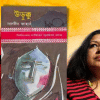Can ideology win over desire?

Shawkat Hussain's The Memsaheb's Foot is a translation of Memsaheber Paa, a 1984 Bangla novella by the late Kashinath Roy. The book was released at the Ekushey Boi Mela this year.
Set in 1990s Dhaka against the backdrop of the military occupation, the novella follows the lives of a young university professor named Ahsan, his wife, and their house help, Phulbanu. The story is narrated entirely from Phulbanu's perspective and utilises dual timelines that slowly converge.
It starts in the present day with a description of Phulbanu's daily activities. These slight glimpses of her day remain interspersed throughout the novella, but the text shifts its primary focus away from Phulbanu and settles on the picture of Professor Ahsan's family life back when Phulbanu first entered their care.
Living on campus at Dhaka University, the professor is visited several times a day by people wishing to converse with him about topics that are far beyond Phulbanu's understanding. From her limited grasp of what these people speak about and the snippets she reiterates to us, we come to know that the professor is a leftist and the people visiting him are activists rebelling against the military regime. The difficult, incomprehensible words they use and the seriousness behind their tones as they discuss riots and food supplies and revolution, leave a mark on Phulbanu. She is mesmerised and their conversation in turn makes us mesmerised with them. We find ourselves admiring this professor who is choosing a path of resistance instead of one of comfort.
Then, suddenly, the gaze shifts to the professor's wife, whom Phulbanu refers to as Memsaheb. Phulbanu is barred from seeing her as anything other than her superior. Her name is kept out of our reach, just as it is kept out of Phulbanu's reach. This solidifies the class difference between the house help and her employer.
Little by little, through Phulbanu's descriptions of her actions, we see the passive aggressiveness with which Memsaheb views her husband's political affiliations and the financial troubles that result from it. Marital conflict ensues, and unpleasant aspects of the couple's sexual relationship are subtly brought forth.
The professor spends his days fighting capitalism and the military regime and his nights making love to his wife, sometimes against her wishes. Memsaheb feels used, she sees her physicality as being the only thing her husband values in her and it makes her deeply insecure and irritable towards him, towards herself and, in turn, towards Phulbanu, who is a growing girl emerging into her own sexuality.
Their volatile sexual relations, the disparity in the ways that the two people regard money, the necessities of a comfortable life and what must be done to achieve it all create a tension between them that crescendoes. As a narrator, Phulbanu does not openly criticise these characters' choice, perhaps because she doesn't fully understand them, but witnessing how easily a person's convictions can waver cannot help but make the reader distraught. Phunbanu, on the other hand, finds in her sexuality the strength with which she can challenge the shackles of class.
The Memsaheb's Foot is a powerful novella, one that explores multiple facets of the human condition. It is a commentary on how a pseudo-leftist society crumbles in the face of emerging capitalism as much as it is a criticism of the class divide, the gatekeeping of knowledge that results from it, and how gender solidarity falls before classism.
Instead of providing a linear timeline of events, the author chooses to build tension and suspense slowly. This keeps readers feeling frustrated throughout the novella; we are itching to know how these two timelines could come together to make a meaningful ending. But the frustrations of the reader are compensated through a powerful climax that is more shocking and dynamic than it would have been with a linear plotline. It perfectly encapsulates the core theme of the novella—which is that human desire knows no end.
The dialogues, the dynamics between the characters, their very aspirations, and actions—everything in Kashinath Roy's text screams 1990s Dhaka. Shawkat Hussain manages to translate it to English while preserving this aspect. The dialogues flow smoothly, nothing seems stunted or redundant. The prose is simple and unadorned, and the novella focuses more on dialogues than on narration itself. This simplicity adds value to novella, making it seem more raw and visceral and disruptive. As readers, we feel as though we are trespassing on the characters' lives, seeing something that was not meant to be seen.
Adrita Zaima Islam is a struggling student, a failed guitarist and a poet in need of better poetic ideas. Send her your sympathies at [email protected].

 For all latest news, follow The Daily Star's Google News channel.
For all latest news, follow The Daily Star's Google News channel. 








Comments